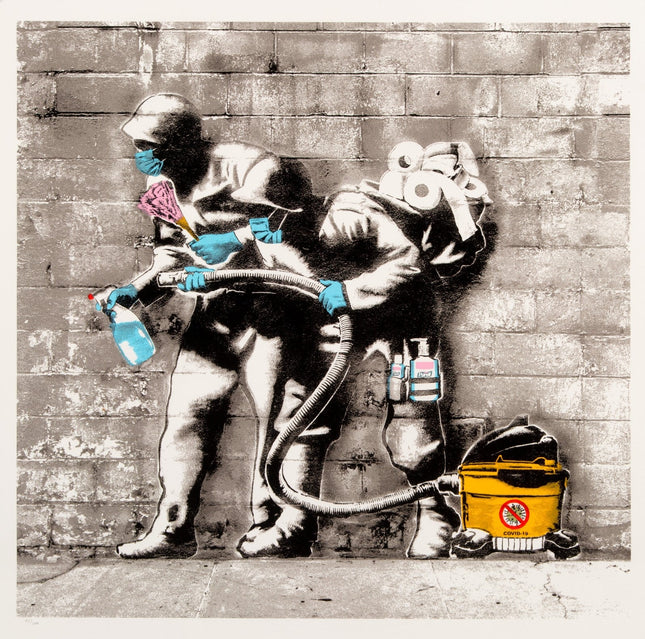
Virus

Hijack Pandemonium Silkscreen Print by Hijack
Pandemonium Hand-Pulled Deckled Color Silkscreen Print on Fine Art Paper by Desirable Artist Hijack Limited Edition Pop Art Artwork. 2020 Hand Numbered & Artist Stamped Limited Edition of 100 Hand-Deckled Artwork Size 22x22. Global Food Bank Covid Charity Print by Hijack. Introducing "Pandemonium" by Hijack: A Street Pop Art Reflection on Global Crisis Crafted amid the tumultuous era marked by the COVID-19 pandemic, the artwork "Pandemonium" by the street artist Hijack seizes the collective consciousness of a world grappling with uncertainty and upheaval. This piece is a hand-pulled, deckled color silkscreen print on fine art paper, embodying the artist's poignant response to the pandemic's impact on society. Hijack, whose real name remains part of his enigmatic persona, has become a notable figure in the contemporary street pop art and graffiti art scene, with works that often delve into the commentary on current events and social issues. The limited edition artwork, sized 22x22 inches, is a visual statement and a philanthropic endeavor, with its proceeds aimed at supporting global food banks during the pandemic. As a part of a limited run of 100 pieces, each hand-numbered and stamped by the artist, "Pandemonium" becomes a collectible piece of history, immortalizing the zeitgeist of the early 2020s. Symbolism and Technique in Hijack's "Pandemonium" "Pandemonium" exudes a striking balance between the immediacy of graffiti art and the calculated precision of pop art silkscreen printing. The image portrays a figure in protective gear, the silhouette and posture reminiscent of a healthcare worker and a biohazard cleaner. This duality highlights the frontline reality of the pandemic. The use of bright colors against the monochrome background draws attention to the subject and infuses the piece with a sense of vibrancy amidst the darkness, a hallmark of street pop art's capacity to find beauty and meaning in the grim and mundane. The fine art paper serves as the urban canvas for Hijack, much like the walls and alleyways of the cityscape serve other graffiti artists. The deckled edges of the paper echo the often rough and transient nature of street art, offering a contrast to the permanence that the limited edition print signifies. It is this interplay of the brief with the enduring that Hijack navigates through "Pandemonium," reflecting on the fleeting nature of the pandemic while capturing a moment in time that will be indelibly etched in history. The Cultural Resonance of "Pandemonium" in Street Art Discourse In the broader discourse of street pop art and graffiti artwork, "Pandemonium" resonates as a cultural artifact, a beacon of the times. The work emulates how street artists have historically used public spaces and accessible mediums to reflect societal sentiments, provoke thought, and inspire action. Hijack's choice to contribute to a global charity through his art reflects a tradition within street art to not only comment on social issues but also actively participate in societal change. The image's depiction of the character with a spray bottle labeled "COVID-19" evokes a sense of action and responsibility, an acknowledgment of the collective efforts to 'cleanse' the world of the viral threat. This representation goes beyond mere aesthetics; it is a rallying cry, a nod to the resilience of humanity in the face of a global crisis, and a testament to the role of art in documenting, responding to, and healing communal traumas. As a piece of street pop art, "Pandemonium" stands out for its ability to capture the essence of an unprecedented global event while maintaining the stylistic and thematic elements that define the genre. Hijack's work is not just an artistic response to a pandemic; it is a historical record and a commentary on the human condition, a reminder of the tumult and triumph that characterize our times. In the legacy of street art, "Pandemonium" will be remembered as a poignant reflection of the era it was created in, a testament to the power of art to encapsulate complex emotions and narratives. It is a visual dialogue between the artist and the world, a piece that speaks to the fear, hope, and indomitable spirit that has defined the human response to the COVID-19 pandemic. Through "Pandemonium," Hijack contributes to the rich tapestry of street pop art and graffiti artwork, which continues to evolve and resonate as a voice of the people in the public domain.
$1,230.00


